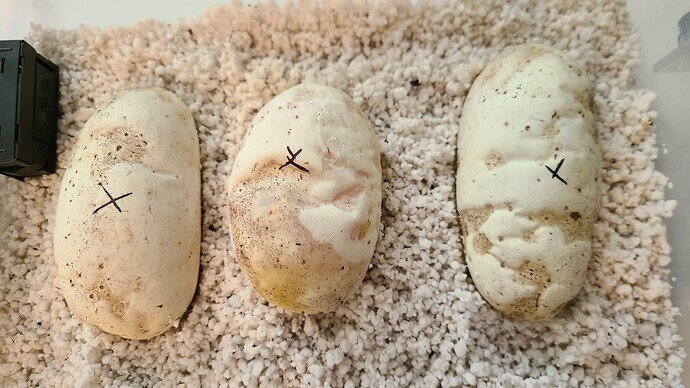One of my females laid her first, and my first, cluth of eggs the other day. 3 were slugs, these 3 look okay-ish, but the yellow spots on the one in the middle have gotten a little bigger, and I dont see any veins in the one on the right. Temp is 88 in the box, 99% humidity but no wetness/condensation inside the box. Am I paranoid or do they look like they’re okay?
They look a bit rough but I’ve had worse hatch lol
I would leave them be and hope for the best constantly checking on them is more likely to hurt than help.
poor calcification … they usually hatch ok in my experience.
Is that a fault of mine, something that can just happen, or related to it being her first clutch?
It happens… I had a few last year and they weren’t all first timers.
It does for sure! I think your feeders diet plays a big role here.
That could be, I bought her as an adult earlier this year, so I don’t know too much about where her last owner got her food
I considered that but with the 17 clutches last year and only a couple with poor calcification I found it hard to believe that the feeders (who eat the same and have all the same set up) would play that big of a role… or wouldn’t it have occurred more?
I have raised my own feeders for the last 5 years and I had more eggs like that when I feed strictly dog food. I still get them when feeding mazuri but at a lower rate. Could just be a coincidence though I’ll admit. No hard science here lol
That’s my experience (not with ball pythons but many other species over the years.)
Yes me too as above.
and for calcification, I never used supplements but focused on good quality (not the cheapest) food items. If its really cheep there is probably a reason. Also expensive is no garmented of quality.
I suggest look at reviews of the food suppliers, also the state of the food item received, how do they look ? How packaged, the smell when defrosted, and discolouration? freezer burn etc, its hard to tell how long they have been frozen for, but too long the previous checks should give you a clue.
or alternative breed your own. Quality in equals quality out.
It’s possible that feeder health aspects we can’t monitor play a roll, but idk about diet. I get a clutch now and then that is poorly calcified, and I raise and select all of my own feeders. They eat Mazuri 6F supplemented with oats, grains, and veggies. I euthanize and compost any feeders that appear to be in poor health. I only select hygienic, heathy appearing rodents out of the bins to feed. Yet I still occasionally get a mis calcified clutch.
Personally I think there are more variables to the situation than we understand or have control of.
A tip for eggs like this though is to make sure you use press n seal or mechanically pip the eggs as eggs that look like these tend to get pretty hard if left to their own devices and could possibly drown a pipper if their egg tooth fails.
As do I!
Agree
I do think it plays a part a rodent on a poor diet probably provides sub par nutrition which trickles down to the snakes general health. A female not receiving proper nutrition probably won’t lay the best eggs.
Did you buy her Gravid? If so the stress of the move may of affected her as well
It’s possible she was ovulating during the move but definitely not gravid. I got her back in early October, she locked with my male in late November, and shed late December, which I thought was get pre-ovulation shed but was apparently her pre-lay.
